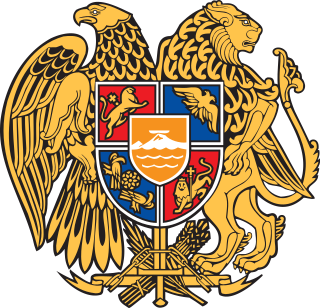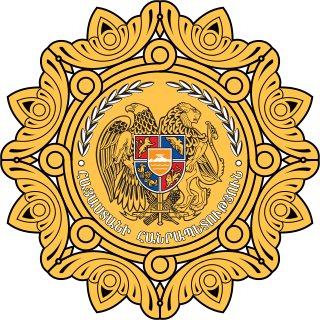
The politics of Armenia take place in the framework of the parliamentary representative democratic republic of Armenia, whereby the President of Armenia is the head of state and the Prime Minister of Armenia the head of government, and of a multi-party system. Executive power is exercised by the President and the Government. Legislative power is vested in both the Government and Parliament.

Vazgen Sargsyan was an Armenian military commander and politician. He was the first Defence Minister of Armenia from 1991 to 1992 and then from 1995 to 1999. He served as Armenia's Prime Minister from 11 June 1999 until his assassination on 27 October of that year. He rose to prominence during the mass movement for the unification of Nagorno-Karabakh with Armenia in the late 1980s and led Armenian volunteer groups during the early clashes with Azerbaijani forces. Appointed Defence Minister by President Levon Ter-Petrosyan soon after Armenia's independence from the Soviet Union in late 1991, Sargsyan became the most prominent commander of Armenian forces during the Nagorno-Karabakh War. In different positions, he regulated the military operations in the war area until 1994, when a ceasefire was reached ending the war with the de facto unification of Nagorno-Karabakh Republic with Armenia.

The Republican Party of Armenia is a national-conservative political party in Armenia. It was the first political party in independent Armenia to be founded and registered. It is the largest party of the right-wing in Armenia, and claims to have 140,000 members.

The Armenian Revolutionary Federation (ARF), also known as Dashnaktsutyun, is an Armenian nationalist and socialist political party founded in 1890 in Tiflis, Russian Empire by Christapor Mikaelian, Stepan Zorian, and Simon Zavarian. Today the party operates in Armenia, Artsakh and in countries where the Armenian diaspora is present. Nowadays it constitutes a minor party, and as of December 2018 was represented in two national parliaments with 7 seats in the National Assembly of Artsakh and three seats in the Parliament of Lebanon as part of the March 8 alliance.

Levon Hakobi Ter-Petrosyan, also known by his initials LTP, is an Armenian politician. He was the first President of Armenia from 1991 to 1998. A senior researcher at the Matenadaran Institute of Ancient Manuscripts, he led the Karabakh movement for the unification of the Armenian-populated Nagorno-Karabakh with Armenia in 1988. After Armenia's independence from the Soviet Union in 1991, Ter-Petrosyan was elected president in October 1991 with overwhelming public support. He led the country through the Nagorno-Karabakh War with neighboring Azerbaijan, during which Armenia supported the Republic of Artsakh in fighting against Azerbaijan.

The Republic of Artsakh, or simply Artsakh, also known by its official name between 1991 and 2017, the Nagorno-Karabakh Republic, is a de facto independent country in the South Caucasus that is internationally recognized as part of Azerbaijan. The region is currently populated mostly by Armenians and the primary spoken language is Armenian. Artsakh controls most of the territory of the former Nagorno-Karabakh Autonomous Oblast and some of the surrounding area, giving it a border with Armenia to the west and Iran to the south. Its capital is Stepanakert.

The National Assembly of the Republic of Armenia, also informally referred to as the Parliament of Armenia is the legislative branch of the government of Armenia.
Christopher Newbury is a British Conservative politician. He was a member of the Congress of the Council of Europe from 1998 to 2010 and since 2009 has been a member of the new Wiltshire Council created that year.

Nikol Pashinyan is an Armenian politician serving as Prime Minister of Armenia since 8 May 2018. He is a former journalist and editor.

The Armenians in Abkhazia form the second largest ethnic group in Abkhazia after the native Abkhazians. Armenians settled in Abkhazia in late 19th and the early 20th centuries and are now the largest ethnic group in Sukhumi, Gulripsh and Gagra districts forming 20% of the Abkhazian population with approximately 42,000 out of a total of 242,862.

A parliamentary election was held on May 6, 2012 in Armenia.

Yerevan City Council election was held on May 5, 2013. The Republican Party of Armenia won 56% of the total vote, Prosperous Armenia had 23%, while Barev Yerevan won over 8%. The opposition parties and the local observers denounced the elections as "unfair".

The President of Armenia is the head of state and the guarantor of independence and territorial integrity of Armenia elected to a single seven year term by the National Assembly of Armenia. Under Armenia's parliamentary system, the President is simply a figurehead and holds ceremonial duties, with most of the political power vested in the Parliament and Prime Minister.

Various political and civil groups staged anti-government protests in Armenia in 2013. The first series of protests were held following the 2013 presidential election and were led by the former presidential candidate Raffi Hovannisian. Hovannisian, who, according to official results, lost to incumbent Serzh Sargsyan, denounced the results claiming they were rigged. Starting on 19 February, Hovannisian and his supporters held mass rallies in Yerevan's Freedom Square and other cities. On 10 March, Hovannisian started a hunger strike, calling elected President Sargsyan to resign before 9 April, the inauguration day. Hovannisian called "for the solution of this unprecedented pan-national fundamental issue before April 9." During an interview on 18 March 2013, Sargsyan said he would not visit Hovannisian and described his claims as "arrogant phrases seasoned with obscenities". Sargsyan was inaugurated on 9 April 2013, while Hovannisian and thousands of people gathered in the streets of Yerevan to protest it, clashing with the police forces blocking the way to the Presidential Palace. Hovannisian's movement was dubbed "Barevolution", a portmanteau of barev and revolution, referring to Raffi Hovannisian's habit of walking up to people and greeting them during the election campaign.

Local elections were held in Armenia on 12 February and 9 September 2012.

The Karabakh movement was a mass nationalist movement in Armenia and Nagorno-Karabakh from 1988 to 1992 that advocated for the transfer of the mainly Armenian-populated Nagorno-Karabakh Autonomous Oblast of neighboring Azerbaijan to the jurisdiction of Armenia.

The dissolution of the Soviet Union occurred on 26 December 1991, officially granting self-governing independence to the Republics of the Union of Soviet Socialist Republics (USSR). It was a result of the declaration number 142-Н of the Supreme Soviet of the Soviet Union, the demolition of the Berlin Wall and removal of the Iron Curtain. The declaration acknowledged the independence of the former Soviet republics and created the Commonwealth of Independent States (CIS), although five of the signatories ratified it much later or did not do so at all. On the previous day, 25 December, Soviet President Mikhail Gorbachev, the eighth and final leader of the USSR, resigned, declared his office extinct and handed over its powers—including control of the Soviet nuclear missile launching codes—to Russian President Boris Yeltsin. That night at 7:32 p.m., the Soviet flag was lowered from the Kremlin for the last time and replaced with the pre-revolutionary Russian flag.

The Central Electoral Commission of the Republic of Armenia organizes elections and referendums of Armenia. It controls the whole electoral process, counts and publicizes results. Before the formation of the Republic of Armenia in 1991, the Central Electoral Committee (CEC) activities were carried out in accordance with the Soviet Socialist Armenian law on the Election of People's Deputies. According to the law adopted in August 2011 concerning organizing and conducting presidential elections of the Republic of Armenia, there should be three levels of electoral committees:
- The Central Electoral Committee of the Republic of Armenia of the President of Armenia
- Urban and Regional Electoral Commissions of the President Elections of the Republic of Armenia
- Precinct Electoral Commissions of the President Elections of the Republic of Armenia

The My Step Alliance is a political alliance formed by the Civil Contract party, the Mission Party and various Independent representatives of civil society. It was formed in August 2018, before the Yerevan City Council election, 2018. The leader of the alliance is the Prime Minister of Armenia Nikol Pashinyan.














